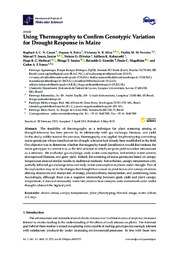Using thermography to confirm genotypic variation for drought response in maize.
Using thermography to confirm genotypic variation for drought response in maize.
Autoria: CASARI, R. A. C. N.; PAIVA, D. S.; SILVA, V. N. B.; FERREIRA, T. M. M.; SOUZA JUNIOR, M. T.; OLIVEIRA, N. G.; KOBAYASHI, A. K.; MOLINARI, H. B. C.; SANTOS, T. T.; GOMIDE, R. L.; MAGALHÃES, P. C.; SOUSA, C. A. F. de
Resumo: The feasibility of thermography as a technique for plant screening aiming at drought-tolerance has been proven by its relationship with gas exchange, biomass, and yield. In this study, unlike most of the previous, thermography was applied for phenotyping contrasting maize genotypes whose classification for drought tolerance had already been established in the field. Our objective was to determine whether thermography-based classification would discriminate the maize genotypes in a similar way as the field selection in which just grain yield was taken into account as a criterion. We evaluated gas exchange, daily water consumption, leaf relative water content, aboveground biomass, and grain yield. Indeed, the screening of maize genotypes based on canopy temperature showed similar results to traditional methods. Nevertheless, canopy temperature only partially reflected gas exchange rates and daily water consumption in plants under drought. Part of the explanation may lie in the changes that drought had caused in plant leaves and canopy structure, altering absorption and dissipation of energy, photosynthesis, transpiration, and partitioning rates. Accordingly, although there was a negative relationship between grain yield and plant canopy temperature, it does not necessarily mean that plants whose canopies were maintained cooler under drought achieved the highest yield.
Ano de publicação: 2019
Tipo de publicação: Artigo de periódico
Unidade: Embrapa Agroenergia
Observações
1 - Por padrão são exibidas publicações dos últimos 20 anos. Para encontrar publicações mais antigas, configure o filtro ano de publicação, colocando o ano a partir do qual você deseja encontrar publicações. O filtro está na coluna da esquerda na busca acima.
2 - Para ler algumas publicações da Embrapa (apenas as que estão em formato ePub), é necessário ter, no celular ou computador, um desses softwares gratuitos. Sistemas Android: Google Play Livros; IOS: iBooks; Windows e Linux: software Calibre.
Acesse outras publicações
Acesse a Base de Dados da Pesquisa Agropecuária (BDPA) para consultar o acervo completo das bibliotecas da Embrapa.

